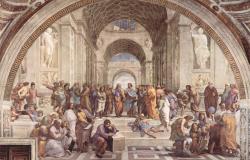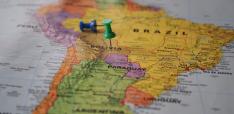Renaissance as a “Cultural Invariant”?

Markus H.-P. Müller explores what the Renaissance can tell us about contemporary cultural and economic shifts.
The Renaissance (15th-16th centuries) provides an obvious example of socio-economic transformation. But was it a one-off event, or should we consider the concept of a Renaissance as a “cultural invariant” in our societies?
In this context, it is crucial to understand what role the socio-economic institutional design of economics along with culture can play in the transformation process of societies and economies. This includes the possible “path dependency” of socio-economic development.
I think that three key elements of the Renaissance process suggest it is a “cultural invariant”.
First, the concept of Renaissance shows us how the rediscovery of a past cultural framework can be important, triggering major changes.
One of the breakthrough moments which preceded the Renaissance was the rediscovery of the pandects, a compendium of legal writings on Roman law (Sorrenti, 2014, p. 2). This prompted the revival of the study of Roman law, as these old concepts were enhanced and applied to contemporary challenges – prompting the formation of European universities and so on. Moreover, Francesco Petrarca (commonly anglicised as Petrarch), scholar and poet of early Renaissance Italy, and one of the earliest humanists, was amongst those who started to put humankind, not God, at the centre of world events. In doing so, he applied ancient historical examples to the present (viri illustres), reflecting on important events (res memorandae) and understanding history as an exemplum. For Giorgio Vasari, Italian architect, artist, and biographer of Italian artists, the “great renewal” happens through direct imitation of nature (Huizinga, 1991, p. 21). This was accompanied by a novel application of mathematics and a fundamentally new conception of perceptible reality and its representation, such as the mathematical modellability of three-dimensional space in planar representation, which had a major impact on art and architecture (Hofmann, 2000). More recently, the early 20th century historian Johan Huizinga accordingly suggested that those who followed the ancients thought themselves as returning to nature.
But, of course, a Renaissance involves not only the emerging arts and rediscovery of forgotten concepts but also their enhancement and evolution by applying them to current challenges and needs. Thus, the process of Renaissance is not only concerned with the looking back but also with a burst forward, as Goody (2010) emphasises. He also sees increased literacy as a key driver of the Renaissance. This was not just important for the growth of knowledge and economic exchange: Written cultures, where language becomes a material object, find it much easier to look back and revive past knowledge. Goody saw this looking back ability as one component of all Renaissances – the other being the forward-looking “efflorescence” of culture and scientific enquiry.
The cumulative impact of such a discovery can therefore be huge, through what Tomasello calls the “ratchet effect”. Once a particular invention has been made, it can pass from one individual to another, causing a whole population to undergo structural development (Müller, 2021). Discoveries will result in new ways of thinking and methods, with the aim of modifying the original concepts and thereby further driving development (Mühlmann, 2005, p. 33-35).
Second, study of the Renaissance shows why path-dependency is a complex issue and why it is important to avoid becoming too deterministic in any future predictions. Braudel talked, of course, about the longue dureé (structural social changes in a long time-frame) but he also referred to the courte dureé (short event-driven upheaval phases). It also shows us how socio-economic development can respond to such disturbances by changing its target path – what the biologist C.P. Waddington dubbed the creode (combining the ancient Greek for “necessary” and “path”).
Third, it reminds us of the importance of self-identification and culture. If individuals can “identify” with socio-economic development, stresses around changes seem more likely to be successfully overcome. One way that such identification can take place is via the dominant culture, e.g., visual and performance art, language, literature, and music. Samuel N. Eisenstadt argued that modernizing societies differ in the way that they have structurally and culturally received and processed their heritage, key to the construction of their collective identities. By taking such a perspective, societies are able to transform the sum of the individual days spent into an overarching narrative (Golding & Kutarna, 2016). Renaissance can thus, in my view, best be understood as a chained development that arises from within itself.
This process of “identification” may be helped by an implicit assumption that cultural achievements will be preserved, providing some form of intellectual heritage, whereas political structures can be easily changed and are therefore uncertain. What this means is that cultural institutions will become a necessary reference point for further economic and social (not just cultural) development (Müller, 2021).
Recent political and economic narratives provide interesting examples of how identification with cultural factors can justify changes in narratives and reassure populations as to its presumed impact.
The campaign for the 2016 Brexit referendum drew on multiple historical and cultural references, presenting past cultural patterns as key to the UK’s promised economic and social Renaissance. The voting majority presumably identified with the proposed change, which was also proposed as a return to a previous, supposedly forgotten cultural framework, our first point.
Before that, the use of the term Chinese Dream in Xi Jinping’s in his inaugural policy pronouncement as the new leader of China was interpreted as a call to national Renaissance and to return China “to its former position”, referring to the heights of past dynasties. This may have helped Chinese society “to believe […] that the Chinese culture’s more humanist tendencies could return” (Chai, & Chai, 2013).
What these two narratives show us is that perceptions of historical culture (not just changes) can have a tangible influence on the development of a country, its society and its economy. The strength of such perceptions should not be underestimated: as Braudel aptly wrote: "The present comes simultaneously from yesterday, the day before yesterday and the once." (Braudel, 1977, p. 60).
However, we should also remember that societies are not necessarily able to make decisions which are independent of the creode (target path). An individual cannot freely decide whether or not he likes the game with which he is involved in and its rules. Consequently, individuals are subject to a limited rationality in their preference setting (in contrast to the neoclassical theories of economics). Hence, individuals behave in a way based on social preferences and prevailing social norms and reciprocity as well as their intrinsic motivation and identity. (Müller, 2021).
The original Renaissance, which concerned not merely Italy, but the whole of Europe, led to an explosion of genius manifest in extraordinary achievements.[1] The effects of current revolutions in the fields of technology, health and economics and their application have a similar potential for disruption, particularly as new methods of global collaboration and knowledge sharing provide increasing opportunities for collective achievement and thus for social transformation. (Golding & Kutarna, 2016)
We should hence discuss the question whether every society and their respective culture can have periods when it experiences a Renaissance, and if we can then deduce that Renaissance is a cultural invariant. The answers to this question are important as they can be used to understand implications for socio-economic developments from a different angle, and to ask relevant questions about possible future policy concepts and responses.
Markus H.-P. Müller is Global Head of the Chief Investment Office and Chief Investment Officer ESG Private Bank, Deutsche Bank AG. Markus has held teaching posts in corporate finance and economics, being a visiting scholar at the Frankfurt School of Finance and the University of Bayreuth as well as at the Banking and Finance Academy of the Republic of Uzbekistan in Tashkent. His main research interests lie in the structural transformation of economies and societies as well as in the area of sustainability. Markus authored several books and articles on the transformation of society and economies. For his latest op-ed, please see here.
Photo by Pixabay
References
Braudel, F. (1977). Geschichte und Sozialwissenschaften, Die longue dureé. In: Block, M. et al. (Ed.), Schrift und Materie der Geschichte, Vorschläge zur systematischen Aneignung historischer Prozesse (pg. 47-85). Frankfurt am Main: Edition Suhrkamp.
Burckhardt, J. (1961). The Civilization of the Renaissance in Italy an essay. New American Library of World Literature.
Chai, W., & Chai, M. L. (2013). The meaning of Xi Jinping's Chinese dream. American Journal of Chinese Studies, 95-97.
Eisenstadt, S. N. (2000). Die Vielfalt der Moderne. Velbrück Wissenschaft.
Goldin, I., & Kutarna, C. (2016). Die zweite Renaissance: Warum die Menschheit vor dem Wendepunkt steht. FinanzBuch Verlag.
Goody, J. (2010). Renaissances: the one or the many?. Cambridge: Cambridge University Press.
Hofmann, K. H. (2000). Angewandte Mathematik in der Renaissance. Crivellis Verkündigung mit St. Emidius. Mitteilungen der Deutschen mathematiker-Vereinigung, 8(4), 26–33. https://doi.org/10.1515/dmvm-2000-0112
Huizinga, J. (1991). Das Problem der Renaissance. Renaissance und Realismus (Bd. 35). Klaus Wagenbach.
Max-Planck-Gesellschaft. (2022). Ursprung des Schwarzen Todes identifiziert. Max-Planck-Gesellschaft. https://www.mpg.de/18797697/0608-evan-ursprung-des-schwarzen-todes-identifiziert-150495-x
Müller, M. (2021, November 30). Why we must debate the future now. Global Policy Journal. Retrieved September 6, 2022, from https://www.globalpolicyjournal.com/blog/30/11/2021/why-we-must-debate-future-now.
Mühlmann, H. (2005). Die humanistische Theorie vom Gerechten. In Ästhetische Theorie der Renaissance Leon Battista Alberti (pg. 24-32). Dolega.
Mühlmann, H. (2005). Das Konvergieren des Schönen und des Gerechten. In Ästhetische Theorie der Renaissance Leon Battista Alberti (pg. 33-35). Dolega.
Sorrenti, A.-M. (2014). Public and Private in the Writings of Leon Battista Alberti (Dissertation, University of Toronto). ProQuest LLC , Ann Arbor, Michigan.
Vasari, G., Pergola, P. D., Grassi, L., Previtali, G., & Rossi, A. (1962). Le vite de Piu Eccellenti Pittori Scultori E architettori. Arti Grafiche Fratelli Magnani.
[1] It is important to note that the plague pandemic of the 14th century decimated up to 30% of society (Max-Planck-Gesellschaft, 2022), making it presumably easier for social identification to take place among the rest of the population.


